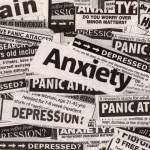Drug Treatment and Emotional Therapy for Anxiety
 In my last article named “Anxiety”, I promised to bring the next one on the same disorder with some more drug usage and emotional therapies. It’s been found that along with drug treatment, the implementation of emotional therapy has brought fruitful results for Anxiety. Therefore, psychiatrists are consulted worldwide for seeking their counsels and suggestions. Keeping this in my mind, I have tried to highlight both ways treatment in this article of mine. The first half of this article talks about effective drugs, which have been used by physicians over a decade while in the last half some useful therapies are being discussed.
In my last article named “Anxiety”, I promised to bring the next one on the same disorder with some more drug usage and emotional therapies. It’s been found that along with drug treatment, the implementation of emotional therapy has brought fruitful results for Anxiety. Therefore, psychiatrists are consulted worldwide for seeking their counsels and suggestions. Keeping this in my mind, I have tried to highlight both ways treatment in this article of mine. The first half of this article talks about effective drugs, which have been used by physicians over a decade while in the last half some useful therapies are being discussed.
In the past, other classes of CNS-active drugs were used for daytime sedation and to treat anxiety. Such drugs included the propanediol carbamates (notably meprobamate), and the barbiturates (see. Their use for anxiety is now obsolete due primarily to their tendency to cause unwanted degrees of sedation or frank intoxication at doses required to alleviate anxiety. Meprobamate and the barbiturates also can induce tolerance, physical dependence, severe withdrawal reactions, and life-threatening toxicity with over dosage.
The antihistamine hydroxyzine is an effective antianxiety agent, but only at doses (about 400 mg per day) that produce marked sedation. Propranolol and metoprolol, lipophilic adrenergic receptor antagonists that enter the CNS, can reduce the autonomic symptoms (nervousness and muscle tremor) associated with specific situational or social phobias, but do not appear to be effective in generalized anxiety or panic disorder. Similarly, other antiadrenergic agents, including clonidine, may modify autonomic expression of anxiety, but have not been demonstrated convincingly to be clinically useful in the treatment of severe anxiety disorders.
Another class of agents with beneficial effects in disorders marked by anxiety or dysphoria of moderate intensity are the azapirones (azaspirodecanediones), currently represented clinically by buspirone (BUSPAR). The azapirones have limited antidopaminergic actions in vivo and do not induce clinical extrapyramidal side effects. Also, they do not interact with binding sites for benzodiazepines or facilitate the action of GABA. They are not anticonvulsant (and may even lower seizure threshold slightly), do not appear to cause tolerance or withdrawal reactions, and do not show cross-tolerance with benzodiazepines or other sedatives. Buspirone and several experimental congeners (e.g., gepirone, ipsapirone, and tiospirone) have selective affinity for serotonin receptors of the 5-HT1A type, for which they appear to be partial agonists.
Buspirone has beneficial actions in anxious patients, particularly those with generalized anxiety of mild or moderate severity. Unlike potent benzodiazepines and antidepressants, buspirone lacks beneficial actions in severe anxiety with panic attacks. It is not efficacious as a monotherapy in obsessive-compulsive disorder, although it may have useful anti-obsessional activity when added to SSRIs (which are efficacious as monotherapy). A lack of cross-tolerance is consistent with a lack of clinical protection against withdrawal-emergent anxiety when changing abruptly from treatment with a benzodiazepine to buspirone; a gradual transition between these classes of antianxiety agents is more likely to be tolerated. Of note, the risk of suicide with buspirone is very low.
The major limitation to developing new antidepressant and antianxiety drugs is a fundamental lack of a coherent pathophysiology and etiology for depression and common anxiety disorders.
Nevertheless, a number of novel products aimed at the treatment of depression or anxiety disorders are in development .These include other inhibitors of neuronal transport of one or more monoamines, including norepinephrine or dopamine, as well as serotonin (e.g., milnacipran); serotonin agonists (e.g., sunepitron,), largely for anxiety; serotonin antagonists (e.g., deramciclane, ), mainly for depression; agents with partial-agonist effects at dopamine and serotonin receptors, much like some atypical antipsychotics ; inhibitors of MAO-A (moclobemide, selegiline); inhibitors of phosphodiesterase 4 ; glutamate -amino-3-hydroxy-5-methyl-4-isoxazole propionic acid (AMPA) receptor modulators (ampakines); glutamate metabotropic receptor agonists for anxiety ; GABAA receptor agonists for anxiety (e.g., ocinaplon, pagoclone); inhibitors of neurokinin-1 (substance-P) receptors ; ligands for cerebral sigma-2 sites ; corticotropin receptor antagonists and the metabolic methyl donor S-adenosyl-L-methionine.
As discussed earlier, along with these drugs some emotional treatment is necessary. If you ever find yourself a patient of anxiety or feel some emotional disturbance, you must change your daily routine and try to add something new which is interesting and attention consuming for you. It helps to divert your attention from the focused issue. Something enjoyable that you may like to do for in leisure can benefit you a lot.
In the same way, if you have a family consisting of few members, start spending some time with them as it will help you come to normal emotional level. Including some picnic programs with your buddies around or hang out with your colleagues for a dinner or lunch will bring good effect on your emotional disturbance. You can try it once in a week if you are too busy to take out time for yourself.
Try to add some sort of daily physical exercise in your schedule. You can add daily running, jogging, long walk or yoga, choose any with which you are the most comfortable. It does wonders if you continue doing it on regular bases. It keeps your spirits fresh and brings you closer to nature. A company to nature can give you the best way to maintain an emotional harmony. Apart from a fresh air outing can lead to bring good results. For a moment, it makes you forget everything and freshen your senses. This is what psychiatrists suggest to every second patient of anxiety.
By: Ammarah Khan




Hey there, You have performed a great job. I’ll certainly digg it and individually suggest to my friends. I’m confident they’ll be benefited from this site.
Hi there, I discovered your web site via Google whilst looking for a comparable subject, your web site got here up, it seems to be great. I’ve added to favourites|added to bookmarks.
Attractive part of content. I simply stumbled upon your blog and in accession capital to say that I acquire actually enjoyed account your weblog posts. Any way I will be subscribing on your augment or even I success you get entry to consistently quickly.
Pretty nice post. I just stumbled upon your weblog and wished to mention that I have truly loved browsing your blog posts. After all I’ll be subscribing for your rss feed and I’m hoping you write once more very soon!
Thank you a lot for sharing this with all of us you really recognise what you’re speaking approximately! Bookmarked. Please also consult with my web site =). We can have a link alternate arrangement between us!
I found your weblog web site on google and test a few of your early posts. Continue to keep up the very good operate. I simply further up your RSS feed to my MSN News Reader. Looking for forward to reading more from you in a while!…
Thank you for the auspicious writeup. It in fact was a amusement account it.
Look advanced to more added agreeable from you! However, how can we communicate?
Amazing issues here. I’m very satisfied to look
your post. Thank you so much and I am looking ahead to touch you.
Will you please drop me a mail?
Hello just wanted to give you a quick heads up and let you know a few of
the pictures aren’t loading correctly. I’m not sure
why but I think its a linking issue. I’ve tried it in two different internet browsers and both
show the same results.